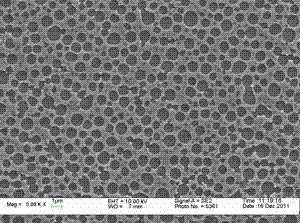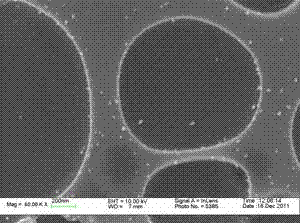Preparation method of recyclable surface-enhanced Raman-spectrum active substrate
A surface-enhanced Raman and active substrate technology, applied in the field of laser Raman spectroscopy detection appliances, can solve the problems of reduced practical availability and increased cost, and achieve the effect of high Raman enhancement effect
- Summary
- Abstract
- Description
- Claims
- Application Information
AI Technical Summary
Problems solved by technology
Method used
Image
Examples
Embodiment 1
[0022] Add 17.08mL of tetrabutyl titanate, 69mL of absolute ethanol, and 2.9mL of glacial acetic acid into a three-necked flask in sequence, and add 0.5mL of acetylacetone, stir magnetically at room temperature for 1 hour, and slowly drop in 11mL of 90.9 % ethanol solution (volume ratio of ethanol / water is 10:1), to obtain light yellow transparent TiO with 0.5mol / L titanium concentration 2 sol, and then 2.01 g of polyethylene glycol 2000 was added to the above sol, stirred and refluxed at 80° C. for 1 hour to obtain a polyethylene glycol-modified TiO2 sol, which was set aside.
[0023] The carrier substrate selected in this example is a quartz glass sheet. The quartz sheet is cleaned with hydrogen peroxide / sulfuric acid mixture (volume ratio 1:4), ethanol, and deionized water, and dried in vacuum at 100°C for 2 hours. figure 1 Schematic diagram of the preparation, immerse the cleaned quartz glass substrate in TiO 2 Sol for 10 minutes, use the pulling method to slowly pull out...
Embodiment 2
[0027] In this example, the surface-enhanced Raman scattering substrate prepared in Example 1 was selected and placed in a 1×10 -5 mol / L of methylene blue aqueous solution soaked for 1 hour, dried naturally, and measured its surface-enhanced Raman spectrum, and the test results were as follows: Figure 4 shown; Figure 4 Show 10 in -5 The Raman signal of mol / L methylene blue on the prepared surface-enhanced Raman scattering substrate is very obvious, and the Raman signal of methylene blue disappears after being irradiated with 12W, 254nm ultraviolet light for 30 minutes. Then soak the substrate in 10 -5 mol / L of methylene blue solution, the surface enhanced Raman signal reproduced, so repeated 5 times, Figure 4 It shows that the surface-enhanced Raman signal has no obvious attenuation. Experimental results show that the number of effective cycles can reach 20 + .
Embodiment 3
[0029]In this example, the surface-enhanced Raman scattering substrate prepared in Example 1 is selected, and first placed in a 1×10 -5 mol / L methylene blue aqueous solution for several times, and its surface-enhanced Raman spectrum was measured. After irradiating with 12 W, 254nm UV lamp for 30 minutes, soak in 1×10 -5 mol / L rose bengal aqueous solution, and then measure its surface-enhanced Raman spectrum. Finally, after irradiating with 12W, 254nm ultraviolet lamp for 30 minutes, soak in 1×10 -5 mol / L crystal violet aqueous solution, measure its surface-enhanced Raman spectrum, the test results are as follows Figure 5 shown; Figure 5 It shows that the Raman signal of methylene blue disappears after being irradiated by a 12W, 254nm UV lamp for 30 minutes, and the substrate is soaked in 10 -5 mol / L rose bengal solution, measured rose bengal high quality surface enhanced Raman signal. The rose red Raman signal disappeared after being irradiated by ultraviolet light ...
PUM
| Property | Measurement | Unit |
|---|---|---|
| Aperture | aaaaa | aaaaa |
Abstract
Description
Claims
Application Information
 Login to View More
Login to View More - R&D
- Intellectual Property
- Life Sciences
- Materials
- Tech Scout
- Unparalleled Data Quality
- Higher Quality Content
- 60% Fewer Hallucinations
Browse by: Latest US Patents, China's latest patents, Technical Efficacy Thesaurus, Application Domain, Technology Topic, Popular Technical Reports.
© 2025 PatSnap. All rights reserved.Legal|Privacy policy|Modern Slavery Act Transparency Statement|Sitemap|About US| Contact US: help@patsnap.com



